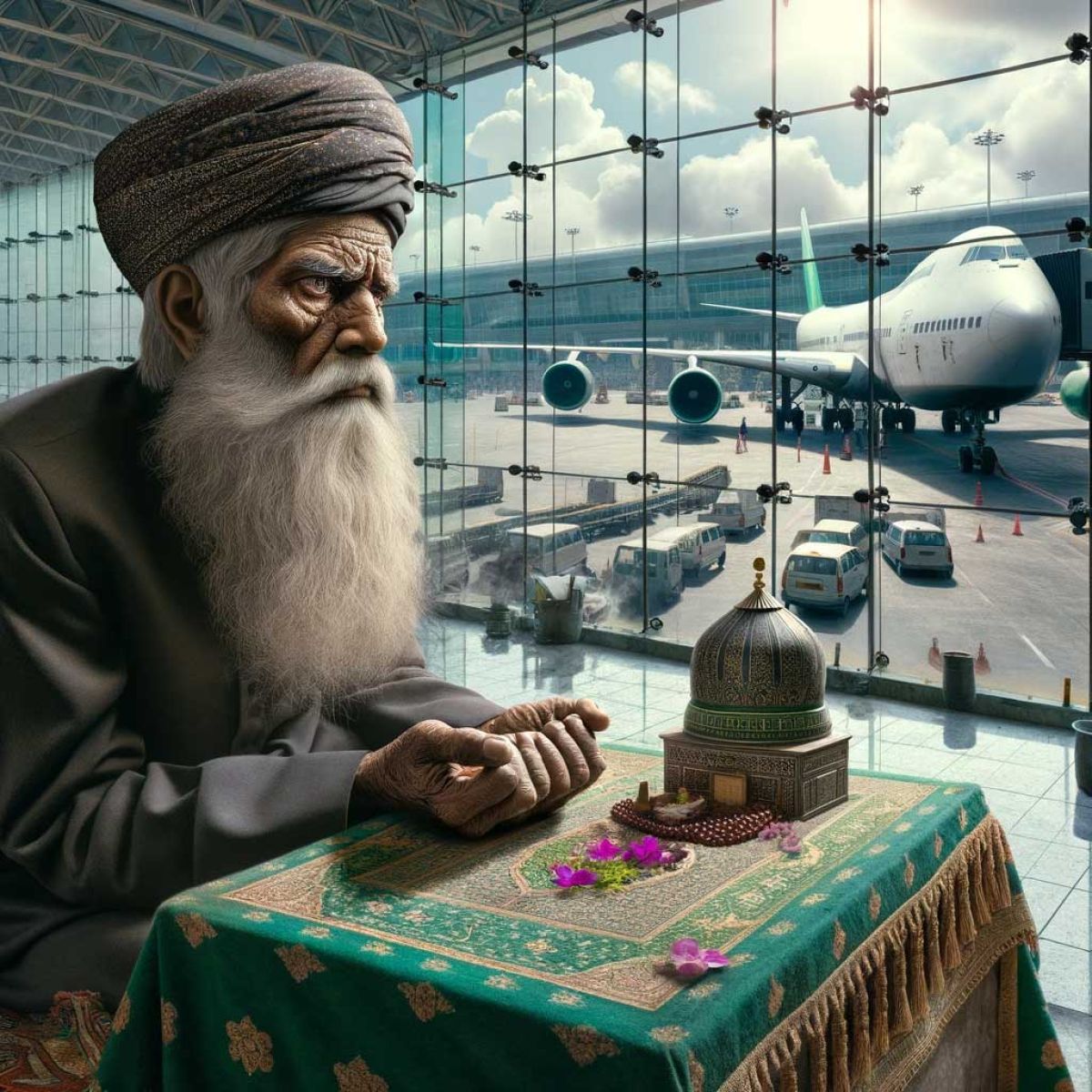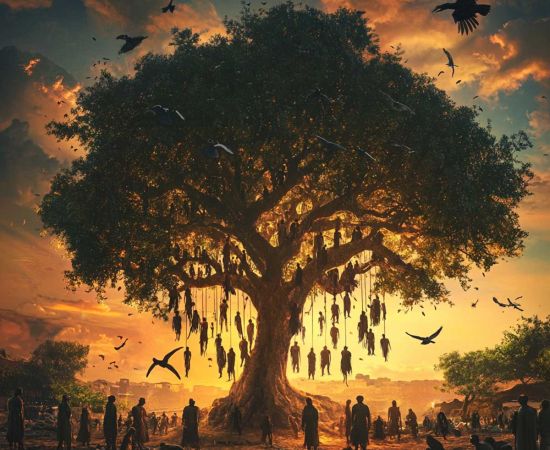MORE COVERAGE
Twitter Coverage
Satyaagrah
Written on
Satyaagrah
Written on
Satyaagrah
Written on
Satyaagrah
Written on
Satyaagrah
Written on
JOIN SATYAAGRAH SOCIAL MEDIA
"Bravo, Hail Secularism": A mazaar exists deep inside Delhi’s Indira Gandhi International Airport @ Terminal 2, alarmingly close to the runway, posing critical questions about security protocols and the extent of Muslim appeasement in vital infrastructure

At the heart of India's bustling capital lies the Indira Gandhi International Airport (DEL, VIDP), not just a gateway for millions but also a home to a unique and somewhat bewildering presence within its boundaries. Situated roughly 16 km southwest of New Delhi's city center, this airport isn't just any airport. Named in honor of Indira Gandhi, a pivotal figure in Indian history and former Prime Minister, it stands as the busiest hub in the nation. With the advent of Terminal 3, its capacity has swelled to accommodate 46 million passengers, and projections suggest this number could more than double to 100 million by 2030, making it not only the largest in India but a titan in South Asian aviation.
Yet, amidst the comings and goings of countless travelers, there lies a secret known to few. Tucked away near Terminal-2 is the ‘Peer Baba ki Dargah’, a sacred site that might seem oddly placed in such a modern and bustling setting. This mazaar, or shrine, serves as the final resting place for two Sufi saints, their presence a stark contrast to the technological marvels and fast-paced operations of one of the world's busiest airports. The ‘Peer Baba ki Dargah’, nestled right beside a runway, presents a curious juxtaposition—a revered and spiritual place amid the roar of airplane engines and the rush of global travelers.
It's as if the airport grew around the dargah, respecting its sanctity and the faith of those who believe in its power. In a city where roads and buildings are often reshaped to accommodate the new, the dargah's persistence is a subtle yet powerful testament to tradition's enduring place in the fast-paced flow of progress. It raises a whimsical eyebrow at the ironies of development: temples might be moved from roadsides to make way for infrastructure, but a dargah within an airport remains untouched, its spiritual significance perhaps offering a different kind of clearance for takeoff.
A traveler destined for the skies must navigate through the maze of modern air travel, which includes spending a considerable sum and enduring stringent security checks. Yet, in an intriguing twist, access to a sacred spot near the runway can be gained with a mere Rs 10 note used to purchase prasad, an offering that ironically becomes a pass into the airport's inner sanctum.
This scenario unfolds within an airport that has expanded voraciously, consuming land to accommodate its growth. Amidst this expansion, where structures were either relocated or razed to make way for progress, some religious sites, notably the ‘Peer Baba ki Dargah’, have remained untouched within the airport's high-security zones. The persistence of such sites raises a bemused eyebrow, highlighting a curious case of selective preservation or perhaps, as some might suggest, a nuanced form of appeasement.
The origins of the shrine remain shrouded in mystery. No one quite knows the when and how of its establishment within the confines of such a critical infrastructure as Delhi’s international airport. The presence of a mazaar dedicated to two Muslim saints on public property, and within a zone of strategic importance, has certainly turned heads. Despite this, it has been a longstanding fixture, revered by many. Employees and visitors alike are granted passage into the highly secure IGI premises, not for travel, but to offer prayers, make wishes, and pay homage at the shrine that quietly asserts its presence near Terminal-2.
The tale dates back to the airport's inception, when, according to some, a tomb was discovered squarely within the intended expanse of the airport. The construction company faced a dilemma: to move the tomb or not. Enter a group of Muslim laborers who, upon learning of the plans to relocate the tomb, reached out to Muslim leaders. The ensuing uproar ensured the tomb's permanence, and today, it stands unyielding within Terminal 2.
This scenario has not gone unnoticed by Indian intelligence agencies, which have repeatedly flagged the tomb as a significant security concern. Despite these warnings, the tomb remains, untouched by the hands of progress or the concerns of security protocols. This immovability paints a stark contrast to the fate of other religious structures, particularly temples, which may find themselves facing demolition for far less than being a security threat, perhaps just for encroaching upon a roadway.
The government's reluctance to address the tomb, despite intelligence advisories, points to a broader narrative of appeasement and the political sensitivities surrounding religious structures. The irony is palpable: a temple obstructing a road can be quickly cleared, yet a tomb within the high-security zones of a major international airport is deemed too sensitive, or perhaps too contentious, to relocate.
The undercurrents of this situation touch upon deeper societal divides. The narrative extends beyond the physical presence of the tomb, hinting at the organized nature of some communities in contrast to the fragmented solidarity of others. In reality, Hindus are divided by castes, but they are organized and their unity lead to significant influence over public decisions and policies.
Public sentiment is reportedly shifting, with growing discontent surrounding the tomb's presence on government property. This discontent is not merely about the tomb itself but what it represents in the broader context of governance, religious accommodation, and security. The enduring presence of the ‘Peer Baba ki Dargah’ within the confines of Indira Gandhi International Airport becomes a focal point for discussions on these issues, highlighting the intricate balance between respecting religious sentiments and ensuring the safety and efficiency of public infrastructure.
The proximity of ‘Peer Baba ki Dargah’ to runway 10/28 accentuates the mazaar's unusual placement within this high-security zone. Visible from the terminals, the shrine has not only integrated itself into the airport's landscape but has also been accorded a remarkable level of accessibility. The Airports Authority of India facilitates this by providing a free bus service from the cargo complex T-2 to the shrine, particularly between 2 pm and 5 pm every Thursday—Jumme Raat—a day imbued with significance for devotees visiting to offer prayers.
The process for those coming to pay homage at the Pir Baba shrine is rigorous yet accommodating. As outlined by a CISF official, "Every devotee entering the airport premises for Pir Baba shrine is frisked and checked by CISF, then taken to escort vehicle up to the shrine and back. No bags are allowed except for chaddar and prasad. The area from gate to Pir Baba is surrounded by CISF quick reaction teams and there is no possibility of any person and any devotee digressing into any other area of the airport." This statement underscores a tightly controlled yet facilitated access, ensuring devotees can practice their faith while maintaining airport security.
A report from India Today in 2011 highlighted the security concerns associated with such accessibility. It noted that offerings like flowers and incense sticks were sold right outside the Customs House at the airport. The report went further, revealing that their team managed to sneak a spy camera all the way to the dargah, close to the runway of one of the busiest airports globally, pointing to lapses in security that have since been addressed.
Tombs of Kale Khan and Roshan Khan, situated next to restricted area between Runway and Blue Dart Hanger.
Nestled within the highly secured confines of the Indira Gandhi International Airport, just a stone's throw away from the bustling Runway and the Blue Dart Hangar, are the tombs of two Sufi saints: Bade Baba (Baba Kale Khan) and Chhote Baba (Baba Roshan Khan). This peculiar location of the mazaar, almost as if in defiance of the stringent security protocols that govern the rest of the airport, offers a fascinating study in contrasts and priorities.
Visitors looking to pay their respects at the dargah are subjected to a security screening at Gate number 6, a necessary ritual to maintain the airport's security. Yet, once past this checkpoint, the usual prohibitions of the airport grounds give way to a more sacred set of rules—no photography allowed, preserving the sanctity of the shrine in a space where surveillance cameras are otherwise ubiquitous. The shrine opens its arms to all Delhi Airport employees on Thursdays, a weekly exception that seems to place spiritual needs on par with operational demands.
The caretakers of the shrine uphold a belief that borders on the mystical, attributing the safety and smooth operation of one of the busiest airports in the world to the spiritual guardianship of the Sufi saints interred within its grounds. “Flights come and go, but our saints are the ones keeping all the operations safe,” they claim.
This belief is not isolated to the caretakers alone; it resonates with a number of the airport's employees who are reported to share in the faith of the saints' protective powers. Among the shrine's relics is a brick, purportedly dating back to 1860, suggesting that the roots of this spiritual site are deeply entwined with the history of the land long before it became a cornerstone of modern aviation.
In a twist that sounds more like the plot of a magical realism novel than the day-to-day operations of one of the world's busiest airports, media reports have brought to light claims by airport employees that attribute miraculous interventions to the ‘Peer Baba ki Dargah’. One such tale involves Satish Singh alias Satish Jha, who recounted an incident where a flight, its engine ablaze upon landing, was reportedly saved as it approached the vicinity of the Dargah, with the fire extinguishing as if by divine intervention. The specifics of the flight and the date of the incident remain shrouded in mystery, adding to the lore that surrounds this sacred site.
Despite the clear security concerns that any rational mind would associate with having a religious shrine within a high-security zone like an airport, the ‘Peer Baba ki Dargah’ continues its silent vigil, its presence justified by devotees as a divine safeguard against calamities. The logic presented—that it is the sanctity of the dead saints that mandates the shrine's unmovable presence—paints a satirical picture of bureaucratic decision-making, where the lines between faith, safety, and governance blur.
Adding to the dargah's intriguing narrative is the annual celebration of “Urs,” a festival that seems to defy the conventional solemnity of an airport's operational environment. That the Airports Authority of India and various airlines partake in organizing grand cultural festivities within the airport premises for this occasion is a testament to the shrine's ingrained place in the local culture and the complex layers of accommodation and appeasement within public institutions. The maintenance of the dargah through devotee donations and the oversight of a dedicated committee, aptly named the “Baba ki Committee,” underscores a community-driven stewardship that transcends the mere physicality of its location.
This final vignette of the dargah’s story at the Indira Gandhi International Airport serves as a sharp critique of the nuanced, often contradictory approaches to governance in spaces shared between the secular and the sacred. It highlights a peculiar juxtaposition where, amidst rigorous security protocols and the relentless pace of modern air travel, space is carved out for faith, tradition, and the belief in supernatural protection.
 |
 Support Us
Support Us
Satyagraha was born from the heart of our land, with an undying aim to unveil the true essence of Bharat. It seeks to illuminate the hidden tales of our valiant freedom fighters and the rich chronicles that haven't yet sung their complete melody in the mainstream.
While platforms like NDTV and 'The Wire' effortlessly garner funds under the banner of safeguarding democracy, we at Satyagraha walk a different path. Our strength and resonance come from you. In this journey to weave a stronger Bharat, every little contribution amplifies our voice. Let's come together, contribute as you can, and champion the true spirit of our nation.
 |  |  |
| ICICI Bank of Satyaagrah | Razorpay Bank of Satyaagrah | PayPal Bank of Satyaagrah - For International Payments |
If all above doesn't work, then try the LINK below:
Please share the article on other platforms
DISCLAIMER: The author is solely responsible for the views expressed in this article. The author carries the responsibility for citing and/or licensing of images utilized within the text. The website also frequently uses non-commercial images for representational purposes only in line with the article. We are not responsible for the authenticity of such images. If some images have a copyright issue, we request the person/entity to contact us at satyaagrahindia@gmail.com and we will take the necessary actions to resolve the issue.
Related Articles
- An Instagram spat between a Hindu and Muslim teen in Nanpara, UP, spiraled into chaos as thousands of Islamists flooded the streets with "Sar Tan Se Juda" chants, doxxing the Hindu boy and demanding his arrest in a disturbing show of religious intolerance
- "Hardest thing to accept as a parent is that you cannot apply the bandage before the bruise": ‘Peace Lover’ Mohammed Bashir abducted a Hindu girl, mentally tortured and raped her for eight days in Bangladesh; accused roaming freely, girl fighting for life
- "Teacher affects eternity; he can never tell where his influence stops": Public uproar in Pune DY Patil High School as Principal Alexander secretly installs CCTV in girls' restroom, forces Christian prayers and disrespects Hindu customs, faces suspension
- "The final battle of Karbala is yet to come": Islamists raised chilling banners with dire warnings, inciting Muslims to fight against 'kafir' Hindus in Maharashtra's Satara district, where SP Samir Sheikh has previously also not acted in similar incidents
- In a major breakthrough, NIA has revealed that the murder of Bajrang Dal activist Harsha was perpetrated to orchestrate communal unrest against the backdrop of the hijab issue: Karnataka
- 16-year-old Shivam has regained consciousness after five days in coma, he and his family took part in the Ram Navami celebration in Khargone when Islamists attacked: He had sustained significant brain damage
- In a surprising twist, the Muslim group that had earlier promised to demolish the illegal 3 floors of Shimla's Sanjauli mosque is now rushing to the High Court, fighting the very order they once agreed to, while the demolition deadline quietly ticks away
- "शफीक और मेरा प्यार फेविकॉल का जोड़": Shafiq Ansari gruesomely slits throat of Hindu girlfriend with a knife that he bought to peel apple for her & pushed her body down a hill, had spent last night together, was ‘upset’ because she was not talking to him
- "ये दोस्ती": In Hyderabad, Sameer Syed, influenced by ganja and suspicious of his best friend Teja's closeness to his sister, decides to take a drastic step, he lures Teja to a private bus and after a few puffs fatally stabs him & slit his throat to death
- "हर की पौड़ी": Haridwar’s Deepotsav stirred controversy as Muslim MLAs were invited to Har Ki Pauri, where non-Hindu entry is restricted; Shri Ganga Sabha, Bajrang Dal, and VHP objected, citing a century-old rule, leading to the invitation’s revocation
- "उस्ताद-ए-रहमत": Maulvi Shahnawaz, head of a Madhubani madrasa, repeatedly raped a 16-year-old minor student, forced her to swear on Quran, gave electric shocks & threatened her life if she disclosed the abuse, surfacing when she became 7 months pregnant
- Telegram channel using images of Hindu women for harassment and abuse is blocked: IT Minister Ashwini Vaishnaw orders action against Channel, Mumbai Police keeps mum
- "It is customers’ right": Declares Ujjain Mayor Mukesh Tatwal, mandating all shops display owners' names and phone numbers prominently, inspired by similar directives from the Uttar Pradesh and Uttarakhand governments for the Kanwar Yatra route
- "Home is a notion that only nations of homeless fully appreciate and only uprooted comprehend": Jharkhand inching towards becoming a separate Islamic nation as Muslims drove out 50 Dalit families from Palamu, National Commission for SCs takes cognizance
- Shivling discovered in the Gyanvapi complex during a survey after the water was pumped out of a well that Muslims were using as 'Wuzukhana' for washing their hands and feet before offering Namaz





























